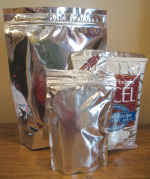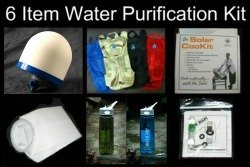Bulk Food Storage Containers
There are several different types of bulk food storage containers that you can use when storing your dry food and grain.

Food Storage Containers
Food Storage Containers
You’ll want to use food grade storage containers. Here are three different types of containers:
Food Storage Buckets

We usually use the four, five, and six gallon buckets. You can buy smaller buckets if you have smaller items. Here are some benefits when using buckets.
- They're great when you have a lot of food to store.
- They keep the mice out of your food. This is especially important if you’re storing your grain and other bulk food storage items in a garage or barn.
- A plastic bucket protects your food from getting wet.
- If you take good care of your buckets and wash them, you can use them over and over again. Buckets are little more expensive up front, but in the long run, they can save you money.
- It’s easy to stack buckets on top of each other, saving you money on food storage shelving.
Back to Top
Food Storage Lids
Bulk food storage containers can be kept right in your pantry. The plastic buckets are hard to open and seal each time you need to use them, so you can use a gamma lid. The outer ring stays on the bucket and the middle section easily screws on and off. Just keep refilling the gamma ring bucket when it's empty. See picture at the top of the page.
#10 Cans

#10 cans are great bulk food storage containers. You can get them at the LDS cannery. They have all the needed equipment. The cannery is a non-profit organization and has low prices on bulk food storage. Visitors Welcome.
- I love my #10 cans because they're small. I can set several of them on the shelf in my pantry.
- The #10 cans are sturdy and airtight.
- Your grain is kept safe from rodents and insects.
- Metal rusts when it gets wet, so you want to keep the cans out of the water.
Back to Top
Mylar Bags

Here are a few points to consider when using Mylar bags as bulk food storage containers:
- Mylar bags are less expensive than buckets and #10 cans.
- They are airtight and keep the insects out of the food.
- They aren’t as sturdy as the buckets and #10 cans and can be punctured easily.
- Mice will chew through a Mylar bag if you have a problem with mice in your storage area.
- They'll work great as a stand alone if you put them on the shelf in a protected area where the mice can’t get to them.
- You can put your food in Mylar bags, and then store the sealed Mylar bags in buckets. The Mylar bag acts as a second barrier. Over time, the oxygen and other gasses can travel through the pores in the plastic buckets. The Mylar bag is airtight. I don’t use Mylar bags inside my buckets, and haven’t had any problems with the grain, but it’s something to consider.
Watch this YouTube and learn how to seal your Mylar bags with a clothing iron.
survivalreport.net Back to Top
Keeping Insects Out of Food
How do insects get into your airtight bulk food storage containers. Sometimes there are insect larvae or eggs in the grain when you store it. When the insects mature, you have bugs in your grain. Here are three different ways to handle the bug problem:
Oxygen Absorbers
Oxygen Absorbers take the oxygen out of the container so that the insects can’t survive.
The 2,000 cc oxygen absorbers are used with the 5-gallon Mylar Bags. The 300 cc oxygen absorbers are used with the 1-gallon Mylar Bags or #10 cans.
I don’t suggest using oxygen absorbers with plastic buckets because it decreases the pressure in the buckets. This causes the air to flow through the pores of the bucket at a faster rate.
Dry Ice
Dry Ice is a very economical way to fumigate your dry food before storing it in bulk food storage containers.
- Pour a little bit of grain, legumes, etc. into the bottom of your five-gallon bucket. This is so you don’t freeze and crack the bottom of your plastic bucket.
- Put one-quarter pound of dry ice in every five-gallon storage bucket. Then pour the rest of your dry food into the bucket. CAUTION: Dry ice will burn your hands, so use gloves when handling it.
- Put the lid on the bucket, but don’t completely seal the bucket.
- As the dry ice evaporates, the CO2 will start to replace the oxygen in the container.
- In about 3-4 hours come back and snap the lid on tight.
- Come back in a few more hours to check on the buckets. If they're bulging, burp the lid by kneeling on the center of the lid and pulling up on one side of the lid. Then make sure the lid is snapped back down into place.
Without oxygen the bugs can’t live.
Back to Top
Diatomaceous Earth
Diatomaceous Earth is my favorite method to use. It takes more time and is a little more expensive.
Seeds are living organisms and need air. If you take the air out of the bulk food storage containers, the seeds will eventually die.
Instead of removing the air from the container, the D. Earth kills the insects without any harm to humans, plants, and animals. D. Earth is the fossilized remains of microscopic shells that are crushed into a powder. The D. Earth cuts up the insects skin. The insect dries up and dies.
Thoroughly mix the D. Earth into the grain. Use 3/4 cup - 1 cup of D. Earth for every 5 gallon bucket. Wear gloves when working with D. Earth because it dries out your skin.
Eating a tablespoon of D. Earth every day has positive health benefits for humans.
If you’d like to learn more about Diatomaceous Earth and how it works,
Earth Works Health has a lot of great information.
Back to Top
Return To:
Food Storage from Bulk Food Storage Containers
Bulk Food Storage
Order
Book of Mormon Stories
|
This is the grain mill that I've used for the last 20 years. It works great. I have some other grain mills as a back up, but I haven't used them yet. This one is still going strong. |
|
|
If you're looking for a quality non-electric grain mill, this is a good choice. It easily adjusts from fine to coarse and grinds virtually all dry grains and legumes, including wheat, corn, beans, peas and amaranth.
|
|
The most important part of bulk food storage is getting your food. If you're looking for an inexpensive hand mill. This will work. It will not produce a superfine flour. It works OK for bread. You'll want to have some sort of hand grain mill in case of a power outage.
|
Dehydrated and freeze-dried food can add a lot of variety and nutrition to your basic bulk food storage. Check out the fruits, vegetables, legumes, and meat substitute.
Water is even more important than food. Think ahead. What are you going to do if you can't get clean drinking water?
There are many ways to purify your water. Here are a few different methods:
- You can use a ceramic gravity water filter.
- On a clear day you can pasteurize your water using the sun.
- If you need something lightweight and easy to carry, try our water bottle with filter or you can use our backpacking water filter








New! Comments
Have your say about what you just read!Leave me a comment in the box below.